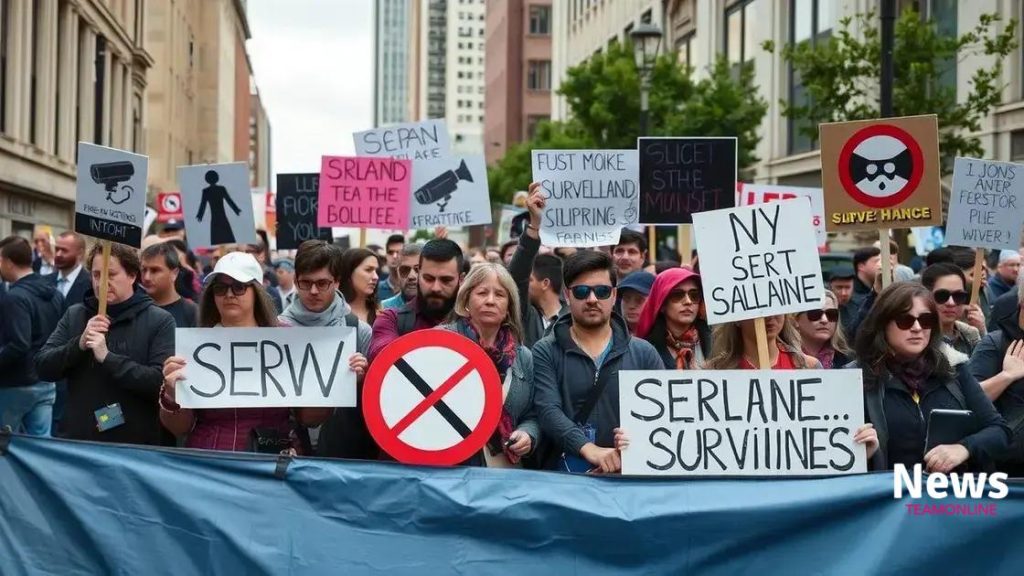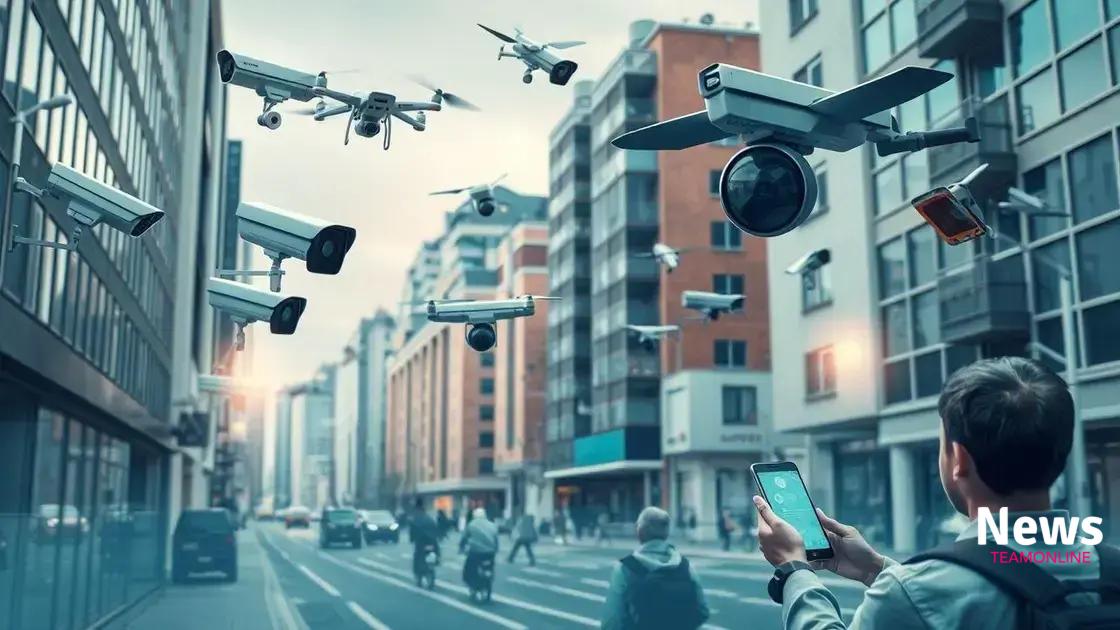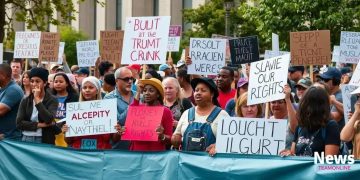Anti-surveillance protest movement: why it matters now

The anti-surveillance protest movement advocates for individual privacy rights against invasive monitoring practices by governments and corporations, emphasizing the need for community engagement and awareness to protect personal freedoms.
The anti-surveillance protest movement is gaining momentum as people worldwide rally against invasive monitoring practices. Have you thought about how these protests impact your daily life and privacy?
Understanding the anti-surveillance protest movement
The anti-surveillance protest movement is crucial in today’s world, as privacy concerns grow. Many people are waking up to the reality of being constantly watched. From street cameras to online tracking, the monitoring of our activities raises questions about personal freedom.
Understanding this movement starts with recognizing how pervasive surveillance has become. This movement emerged from a desire to protect individual rights against unchecked governmental and corporate surveillance.
Key Aspects of the Movement
Activists are fighting for transparency and accountability. The following points highlight the motivations driving these protests:
- Increasing awareness about data privacy
- Opposition to mass surveillance by governments
- Demand for clearer regulations on data usage
- Call for technology companies to be held accountable
People are joining protests, signing petitions, and advocating for policies that favor privacy protections. Their goal is not just to stop surveillance but to reclaim their freedom. Surprisingly, many believe that it is essential to take a stand now more than ever.
Impact on Society
The anti-surveillance protest movement is impacting society in various ways. It’s bringing together diverse groups who share the common goal of fighting against privacy violations. The momentum has led to increased public discussions about surveillance.
Additionally, the movement encourages educators and community leaders to engage with the issue. They are informing others about the risks of surveillance and why it’s vital to combat it. With sustained efforts, people hope to prompt legislative changes that would enhance privacy rights.
In summary, the anti-surveillance protest movement is a necessary response to an increasing threat to personal privacy and freedom. Understanding its implications is the first step toward engaging meaningfully with these vital issues.
Key events that shaped the movement
Throughout history, several key events have significantly shaped the anti-surveillance protest movement. These moments have galvanized public opinion and mobilized action against intrusive monitoring practices.
The Birth of Awareness
One of the earliest sparks for this movement came from media revelations about spying by government agencies. When documents revealing extensive surveillance practices were leaked, many citizens felt a wake-up call about their privacy.
- The Snowden revelations in 2013 uncovered the extent of NSA’s surveillance programs.
- The public outcry led to discussions around government accountability.
- Many began to understand the implications of living under constant watch.
These revelations fostered a more informed and engaged citizenry. People started to question how data about their daily lives was collected and used.
Important Protests
Over the years, protests have played a crucial role in advancing the anti-surveillance protest movement. Demonstrations have provided a platform to voice concerns about privacy violations.
Key protests, such as those in major cities, have showcased the movement’s growth. Activists gather, holding signs and shout slogans, demanding an end to invasive surveillance practices.
- Protests against the Patriot Act aimed to limit surveillance measures.
- The #StopWatchingUs rally in 2013 saw thousands unite.
- Recent movements have focused on local surveillance technology, such as facial recognition.
Each of these events gathered momentum, bringing diverse groups together in the fight for basic rights. Communities are recognizing that privacy is not just a personal concern but a collective issue.
The movement continues to evolve as new challenges arise. Laws and technology change, and with them, the struggle for privacy and against surveillance intensifies. As more individuals join, they share their stories, which further strengthens the call for change.
The role of technology in surveillance

Technology plays a pivotal role in modern surveillance, greatly impacting privacy. Today, we see devices everywhere, from cameras on street corners to smartphones in our pockets, constantly collecting data.
Types of Surveillance Technology
Various technologies enable surveillance, creating a complex environment for personal privacy. Understanding these technologies is vital for recognizing their impact.
- Facial Recognition: Used in public spaces to identify individuals.
- Drones: Equipped with cameras that monitor large areas.
- GPS Tracking: Tracks individual locations through mobile devices.
- Social Media Monitoring: Analyzes online behaviors and interactions.
Each of these tools has benefits but also poses significant concerns. For instance, while facial recognition can help catch criminals, it can also lead to wrongful identification and privacy breaches.
The Impact of Data Collection
The collection of data through technology raises questions about who is watching and why. Many devices track daily activities, leading to increased surveillance.
Data collected can be used for various purposes, such as marketing or law enforcement. However, the risk of misuse also grows.
- Companies often collect more data than necessary.
- Governments may exploit data for surveillance beyond just public safety.
- Without proper regulations, individual rights can be compromised.
As technology advances, the challenge grows in balancing security and privacy. The anti-surveillance protest movement advocates for stricter regulations to protect people’s rights against intrusive technologies.
The conversation about surveillance continues to evolve. Awareness about the technology’s role in monitoring will help citizens understand the implications. By recognizing these issues, people can better fight against unwanted surveillance.
Government responses to the protests
Government responses to the anti-surveillance protest movement have varied significantly across regions and situations. In many cases, authorities react with measures that reflect their stance on privacy and public dissent.
Different Strategies
Governments can take different approaches when faced with protests against surveillance. These strategies range from engaging with protestors to implementing stricter laws. Understanding these responses is important for recognizing the broader implications for society.
- Dialogue and Engagement: Some governments choose to open communication channels with protestors to discuss their concerns.
- Legislative Changes: In response to public pressure, certain administrations have revised or introduced laws aimed at protecting privacy.
- Crackdowns: Some governments respond with force, deploying police to disperse protestors or using surveillance to monitor demonstrators.
- Ignorance: In some cases, authorities may neglect the protests altogether, hoping they will lose momentum.
These strategies can create significant consequences for the future of privacy rights. When a government engages with citizens, it can lead to positive change and reforms. However, aggressive responses often escalate tensions and may further motivate activists.
Impact on Activists and Public Sentiment
Government reactions also have a profound impact on activists and public sentiment. Many individuals may feel discouraged if they perceive a heavy-handed approach. Conversely, when some proposals are accepted, it can bolster community support for the movement.
This dynamic encourages more people to speak up about their rights and engage in activism. For instance, protests against surveillance techniques may become more frequent, generating more debate and visibility around the topic.
Understanding how governments respond to these protests helps frame the ongoing dialogue about privacy. As technology advances, the push for privacy rights will likely continue to intersect with governmental authority.
How to get involved and support the cause
Getting involved in the anti-surveillance protest movement is easier than many think. Individuals can take various steps to support this vital cause and make their voices heard.
Join Local Organizations
One effective way to engage is by joining local organizations that focus on privacy rights and surveillance issues. These groups often have resources and events that can help amplify your voice.
- Attend meetings: Many organizations hold regular meetings to discuss strategies and events.
- Volunteer: Offer your time to support campaigns, such as organizing protests or educational workshops.
- Network: Connect with other activists to learn and share ideas.
By getting active with these groups, you can have a direct impact on the movement and its local initiatives.
Spread Awareness
Raising awareness about surveillance and privacy issues is crucial. You can do this by talking to friends, family, and coworkers about the movement’s goals. Share articles or resources on social media to widen the conversation.
Many people do not realize how prevalent surveillance is in daily life. Educating others can spark interest and motivate them to engage. Host discussions, share flyers, or create informative content to address these topics.
Participate in Protests
Participating in protests is a powerful way to show support. Demonstrations often attract media attention, which can lead to greater awareness. Here’s how to get involved:
- Find local events: Check online platforms and community boards for upcoming protests.
- Follow guidelines: Ensure you know the rules and expectations for participation to remain safe.
- Bring friends: Mobilizing others to attend can amplify your impact at protests.
Being part of these actions can make a statement and help promote change.
By taking these steps, you can contribute to the anti-surveillance protest movement, advocate for privacy rights, and actively engage in protecting everyone’s freedoms. Every action counts, and together, individuals can create a significant difference.
In conclusion, the anti-surveillance protest movement is more important than ever as technology continues to invade our privacy. By understanding the movement, its key events, and how to get involved, each person can play a vital role in advocating for privacy rights. Whether through local organizations, participating in protests, or raising awareness, collective efforts can lead to meaningful change. Protecting our freedom and privacy should be a shared responsibility. Let’s stand together to make our voices heard and support the fight for privacy rights.
FAQ – Frequently Asked Questions about the Anti-Surveillance Protest Movement
What is the anti-surveillance protest movement?
The anti-surveillance protest movement seeks to protect individual privacy rights against intrusive surveillance by governments and corporations.
How can I get involved in the movement?
You can get involved by joining local organizations, participating in protests, spreading awareness online, and volunteering your time for campaigns.
What are some key events in the movement’s history?
Key events include the Snowden revelations in 2013, widespread protests against the Patriot Act, and recent movements focused on facial recognition technology.
Why is raising awareness about surveillance important?
Raising awareness helps educate others about privacy issues, motivates them to take action, and can lead to meaningful discussions and changes in policy.





